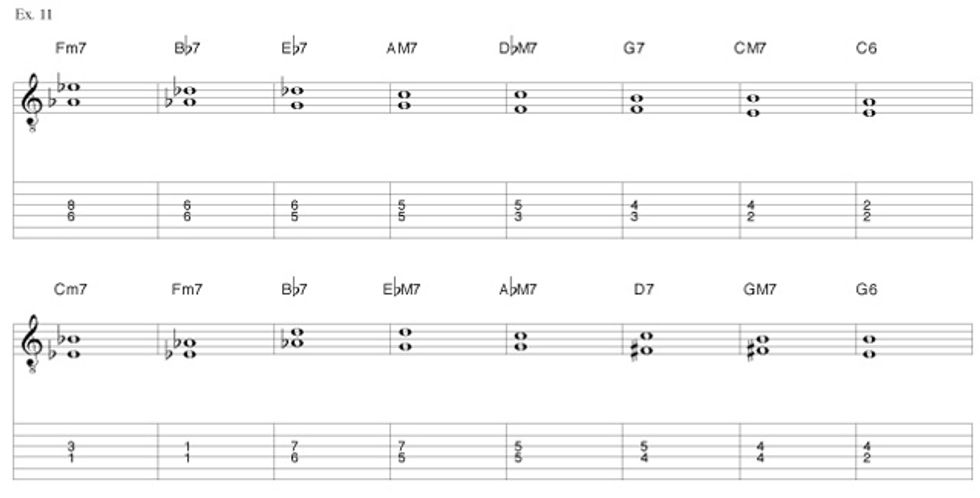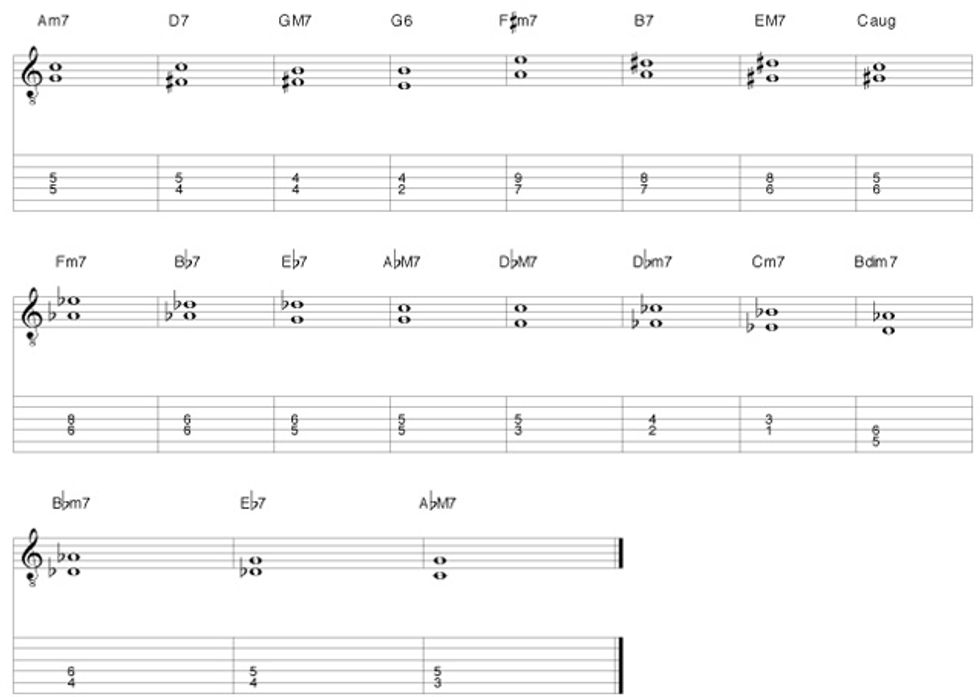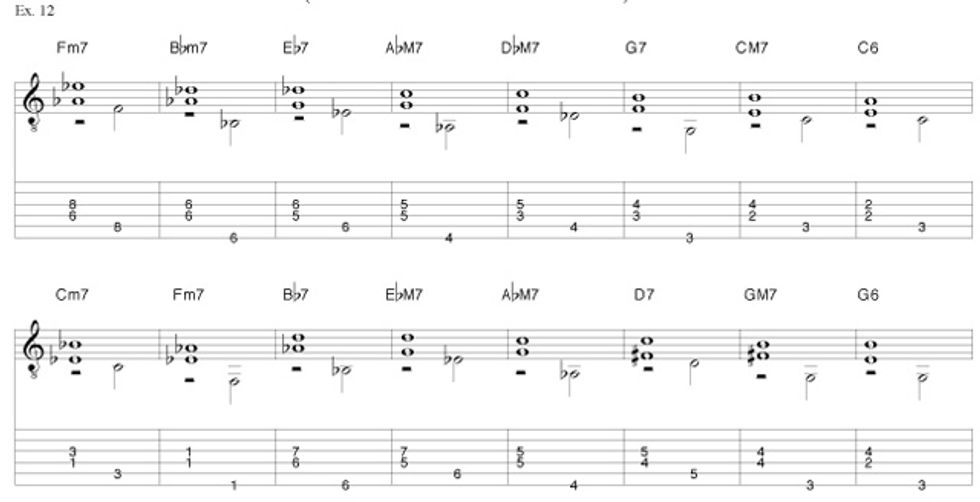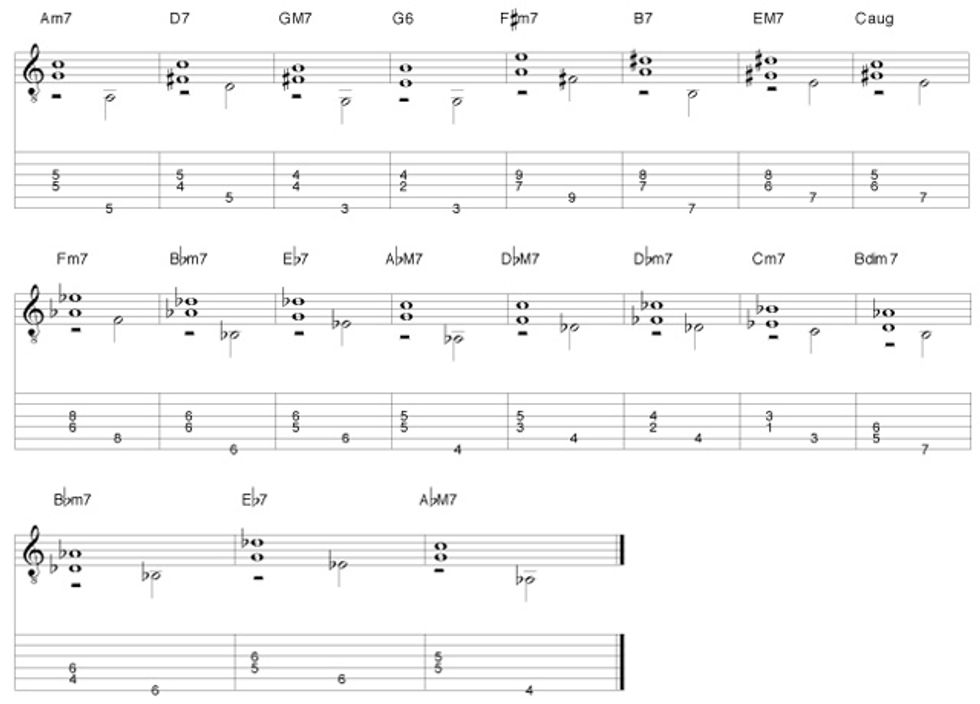| Click here to download a high-resolution, printable PDF of this lesson. |
The first thing we all do is to learn the first position chords and barre chords that contain doubling of notes. While this makes for a full sound while playing rhythm guitar, it is unnecessary for solo guitar playing. Our goal is to outline the basic chord sound while allowing room for the melody and bass.
Many years ago I was advised to take any tune I was working on and make an exercise of playing just the third and seventh of every chord in the progression. You may be surprised how hard this is. It’s just not part of most guitarists’ understanding of the fingerboard.
The following examples are progressions based on the chords found in “Satin Doll” and “All The Things You Are.” I’ve also included a couple turnarounds. I’ve also included short descriptions for each example.
Ex. 1 outlines the progression only using three and seven. Notice that I have ended the progression with the sixth tone on the C chord. Download audio example...

Ex. 2 is the same progression with roots of the chords added in. You’ll now hear it as if you had a bass player. Your ear will eventually begin to hear the bass notes even if they are not played. It’s also a good exercise to sing the bass line. Play the thirds and sevenths while singing the bass line. Download audio example...

Ex. 3 is the same progression using only three and seven, but this time starting the first chord D minor with the seventh on the bottom. Note: the combination of three and seven can also be seven and three. In other words, the order can be changed. Also note that we move to the closest order based on where you start. This allows proper voice leading by maintaining common tones. Download audio example...

Ex. 4 simply adds the bass line and maintains the same order of three and seven as example #3. Download audio example...

Ex. 5 adds a note above each third and seventh. Remember, I said this technique will open the fingerboard and give you space to play extension of 9-11-13. Take note of the chord symbols in this example. Download audio example...

Ex. 6 is a 1-6-2-5 turnaround in the key of G. The six and two chords are dominant sevenths, not minor as normally found in the harmonized major scale. Note that the first chord is a sixth chord. The sound of the sixth can always replace a major seventh chord and is often preferred. Download audio example...

Ex. 7 is the same as #6, however I’ve changed the order of the third and seventh. Download audio example...

Ex. 8 is just a little musical treat for you that shows how you can take the basic three and seven and build interesting melodic ideas and bass lines on top and below. At this point I always hear the foundation of three and seven inside no matter what is being added to it. It’s the foundation. Download audio example...

Ex. 9 is another turnaround, but this time the progression is 1–#1dim–2–#2dim–3–b3–2–5. This example is without the bass. It’s important to note that because the G# dim. and A# dim in this example are not truly diminished until you add the bass note. I chose to notate them as such for the purpose of showing the upper tones of the chords. Note: Diminished seventh chords do not contain the seventh. The interval of a 6th takes the place of the b7. This is the difference between half diminished and full diminished. Download audio example...

Ex. 10 is the same as #9 but with the bass added. Now you’ll be able to hear those diminished sounds. Download audio example...

Go to page 2 to see chord progressions based on "All the Things You Are" in thirds and sevenths...


Ex. 12 is also based on “All The Things You Are,” but now with bass notes below the thirds and sevenths. Download audio example...


I promise that if you gain control of the third and seventh it will completely change your understanding of music and the fingerboard. Give it time and eventually your fingers will know all the thirds and sevenths—and more importantly, your ears will.











![Rig Rundown: Russian Circles’ Mike Sullivan [2025]](https://www.premierguitar.com/media-library/youtube.jpg?id=62303631&width=1245&height=700&quality=70&coordinates=0%2C0%2C0%2C0)













